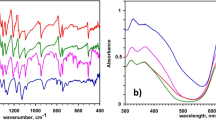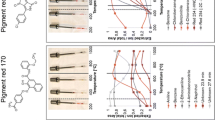Abstract
Synchrotron radiation X-ray fluorescence spectroscopy, in conjunction with atomic absorption and Raman spectroscopy, was used to analyze a set of top brand tattoo inks to investigate the presence of toxic elements and hazardous substances. The Cr, Cu, and Pb contents were found to be above the maximum allowed levels established by the Council of Europe through the resolution ResAP(2008)1 on requirements and criteria for the safety of tattoos and permanent makeup. Raman analysis has revealed the presence of a set of prohibited substances mentioned in ResAP(2008)1, among which are the pigments Blue 15, Green 7, and Violet 23. Other pigments that were identified in white, black, red, and yellow inks are the Pigment White 6, Carbon Black, Pigment Red 8, and a diazo yellow, respectively. The present results show the importance of regulating tattoo ink composition.



Similar content being viewed by others
References
Europe C, Resolution ResAP (2008)1 on requirements and criteria for the safety of tattoos and permanent make-up (superseding Resolution ResAP(2003)2 on tattoos and permanent make-up) 2008
Deter-Wolf A, (2013) The material culture and Middle Stone Age origins of ancient tattooing in “Tattoos and Body Modifications in Antiquity: Proceedings of the sessions at the EAA annual meetings in The Hague and Oslo, 2010/11”. Zurich Studies in Archaeology. 9. Chronos Verlag. pp. 15–26
Piccinini P, Pakalin S, Contor L, Bianchi Senaldi C (2016) JRC science for policy report: safety of tattoos and permanent make-up final, European commission technical report 2016
U. S. Food and D. Administration (2009) FDA Consum Health Information
Vasold R, Engel E, Konig B, Landthaler M, Baumler W (2008) Health risks of tattoo colours. Anal Bioanal Chem 391:9–13
Serup J (2017) Atlas of illustrative cases of tattoo complications. Curr Prob Dermatol 52:139–229
Cuyper C (2010) Materials used in body art. In: Cotapos M, Cuyper C (eds) Dermatologic complications with body art - tattoos, piercing and permanent make-up. Springer-Verlag, Berlin Heidelberg, pp 13–26
Forte G, Petrucci F, Cristaudo A, Bocca B (2009) Market survey on toxic metals contained in tattoo inks. Sci Total Environ 407:5997–6002
Eghbali K, Mousavi Z, Ziarati P (2014) Determination of heavy metals in tattoo ink. Biosci, Biotechnol Res Asia 11:941–946
Schreiver I, Hutzler C, Andree S, Laux P, Luch A (2016) Identification and hazard prediction of tattoo pigments by means of pyrolysis-gas chromatography/mass spectrometry. Arch Toxicol 90:1639–1650
Poon KWC, Dadour IR, McKinley AJ (2008) In situ chemical analysis of modern organic tattooing inks and pigments by micro-Raman spectroscopy. J Raman Spectrosc 39:1227–1237
Cinotti E, Labeille B, Boukenter A, Ouerdane Y, Cambazard F, Perrot JL (2015) Characterization of coal tattoos by Raman spectroscopy. Skin Res Technol 21:511–512
Bocca B, Sabbioni E, Micetic I, Alimonti A, Petrucci F (2017) Size and metal composition characterization of nano- and microparticles in tattoo inks by a combination of analytical techniques. J Anal At Spectrom 32:616–628
Høgsberg T, Loeschner K, Löf D, Serup J (2011) Tattoo inks in general usage contain nanoparticles. Br J Dermatol 165:1210–1218
Riesemeier H, Ecker K, Gorner W, Muller BR, Radtke M, Krumrey M (2005) Layout and first XRF applications of the BAMline at BESSY II. X-Ray Spectrom 34:160–163
Guerra M, Manso M, Pessanha S, Longelin S, Carvalho ML (2013) Theoretical and experimental study on the angular dependence of scattering processes in X-ray fluorescence systems. X-Ray Spectrom 42:402–407
EC for Standardization (CEN), European standard EN 14084—foodstuffs determination of trace elements determination of lead, cadmium, zinc, Copper and iron by atomic absorption spectrometry (AAS) after microwave digestion 2003
EP Agency, Test method 7473: Mercury in solids and solutions by thermal decomposition, amalgamation and atomic absorption spectrometry. SW-846, USA 1998
Cao P, Bismuth oxychloride (biocl) pigment comprising ‘locked in’ carbon black particles (2004) WO Patent App. PCT/US2003/025,781
Fremout W, Saverwyns S (2012) Identification of synthetic organic pigments: the role of a comprehensive digital Raman spectral library. J Raman Spectrosc 43:1536–1544
Basketter DA, Angelini G, Ingber A, Kern PS, Menné T (2003) Nickel,chromium and cobalt in consumer products: revisiting safe levels in the new millennium. Contact Dermatitis 49:1–7
Official Journal of the European Communities, 1976, last amended September 24, 2008
Bouchard M, Rivenc R, Menke C, Learner T (2009) Micro-FTIR and micro-Raman: study of paints used by Sam Francis. e-PS 6:27–37
Acknowledgments
We thank HZB for the allocation of synchrotron radiation beamtime.
Funding
This study was supported by the Portuguese Foundation for Science and Technology grants BPD/92455/2013 and SFRH/BPD/94234/2013 and by the research center grant no. UID/FIS/04559/2013 to LIBPhys-UNL, from the FCT/MCTES/PIDDAC.
Author information
Authors and Affiliations
Corresponding author
Rights and permissions
About this article
Cite this article
Manso, M., Pessanha, S., Guerra, M. et al. Assessment of Toxic Metals and Hazardous Substances in Tattoo Inks Using Sy-XRF, AAS, and Raman Spectroscopy. Biol Trace Elem Res 187, 596–601 (2019). https://doi.org/10.1007/s12011-018-1406-y
Received:
Accepted:
Published:
Issue Date:
DOI: https://doi.org/10.1007/s12011-018-1406-y




